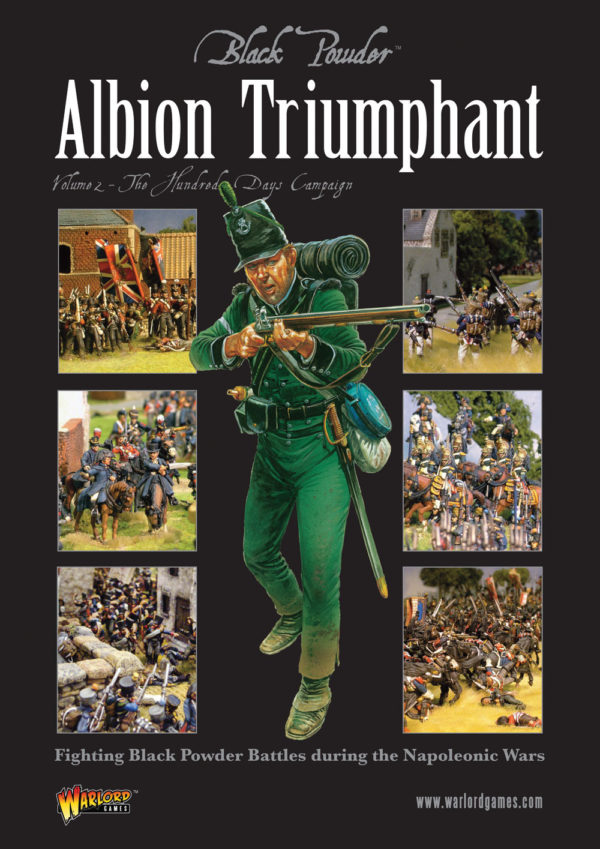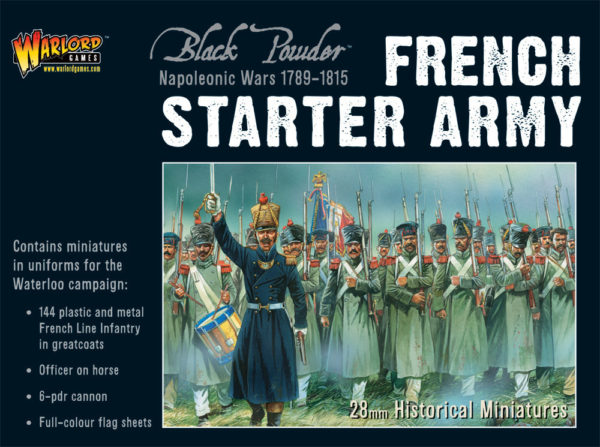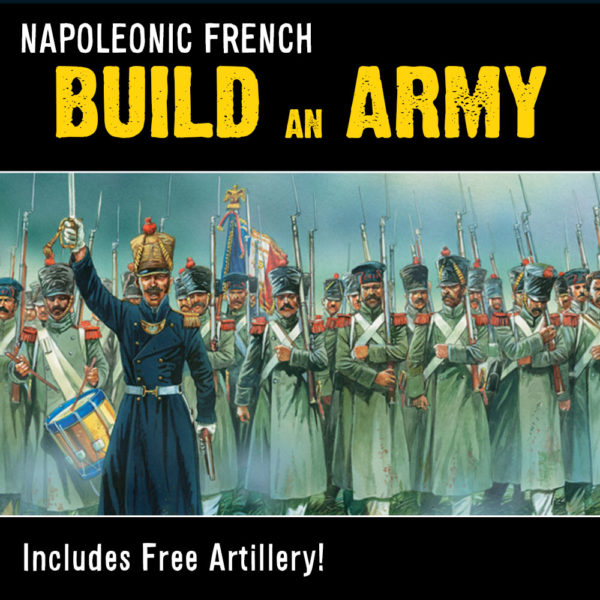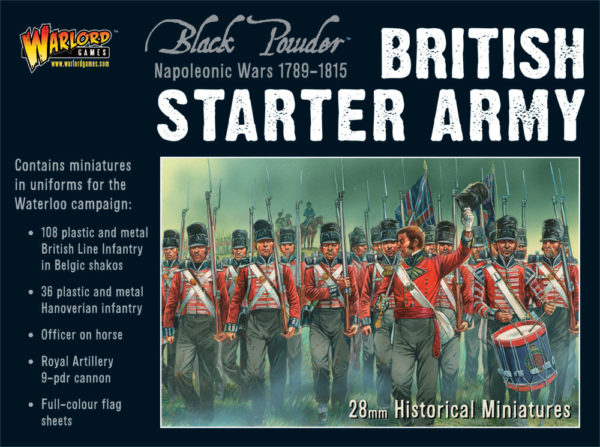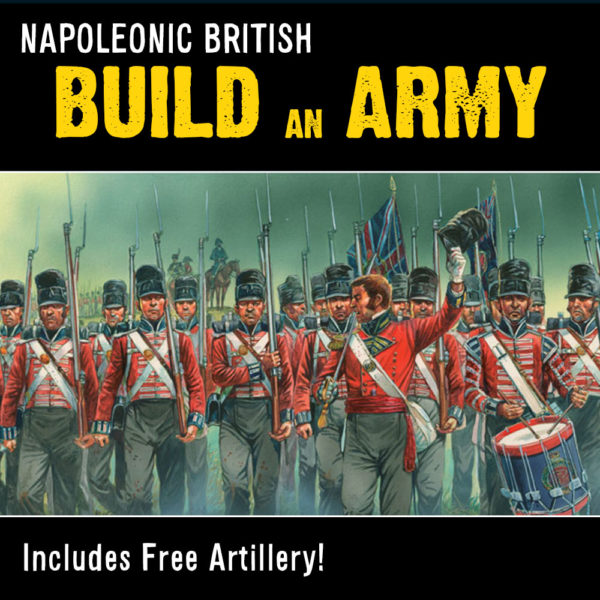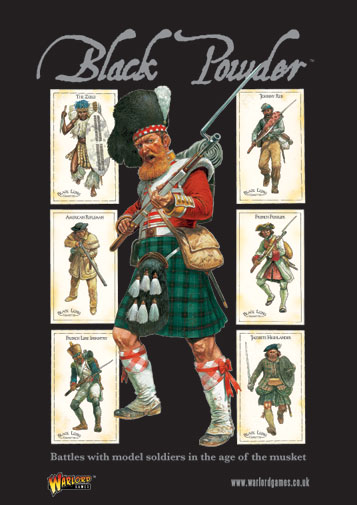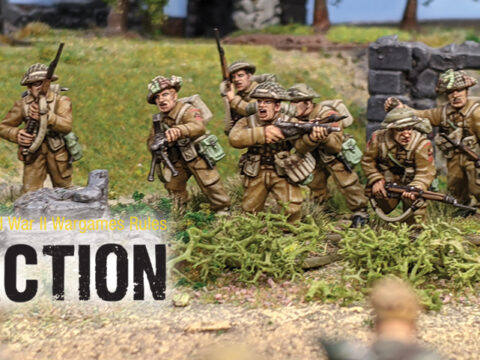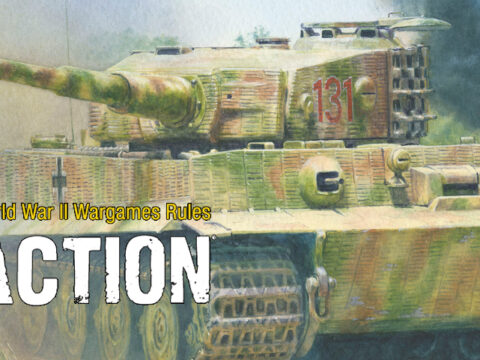The Road to Waterloo: From Both Sides of the Atlantic
By Les Mansir and Richard Caldwell
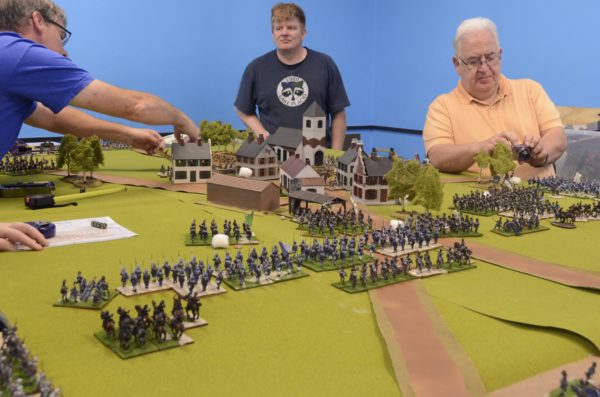
We left Richard and Les preparing for painting, with the familiar dilemma of how to paint the remaining balance of the 1800 troops in the remaining six months?
At Richard’s usual leisurely pace it would take him 24 months to complete so many detailed figures. He had to up his production by a factor of four. Les already had a tried and true painting system.
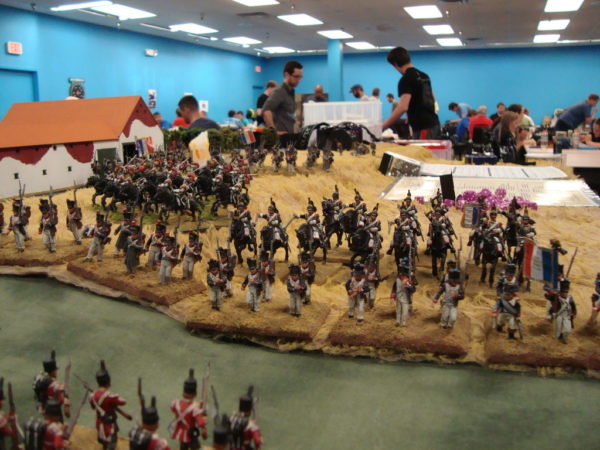
Preparation
Richard’s technique for mass production involves a egg crate frame about 12 inches square that he made several years ago, to hold figures for undercoating and painting. Mounting pieces on clothes pins with flattened tops using artist’s temporary mounting gum whilst for metal horses the use of a hot glue gun is needed due to the weight. Be warned though, using hot glue on plastic makes it tricky to pry off the figures without damaging the base. Richard undercoats in white (so he can see the detail, Grey works well also but black is a real strain on his aging eyes!).
By painting the same parts on all the figures then going back and touching up details on each one, he can work on a whole Brit line battalion at one time – Thus regiments would be built, alternating French and British so that Richard could have a balanced force in case he ran out of time… admittedly with such a large project Richard finally adopted painting a company at a time to provide the gratification of seeing troops assembled ready for action. Les used the principal of painting six figures at a time from soup to nuts.
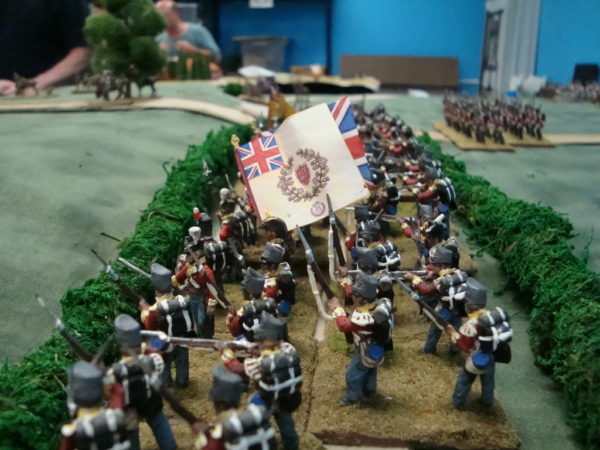
By mid February Richard had assembled and painted 20 battalions of infantry, 22 squadrons of cavalry and 12 batteries of artillery plus the Rocket battery from the collectors set. Three more French battalions arrived from Warlord to add to and make up for one battalion converted to Nassau-Usingen troops who defended the woods to the south of Hougomont. Well Richard had to confess that he recalled to service the surviving metal figures from 45 years ago. These lads, suitably rebased for Black Powder, rallied to the colours. Those troops were from the Imperial Guard including infantry, cavalry and horse artillery.
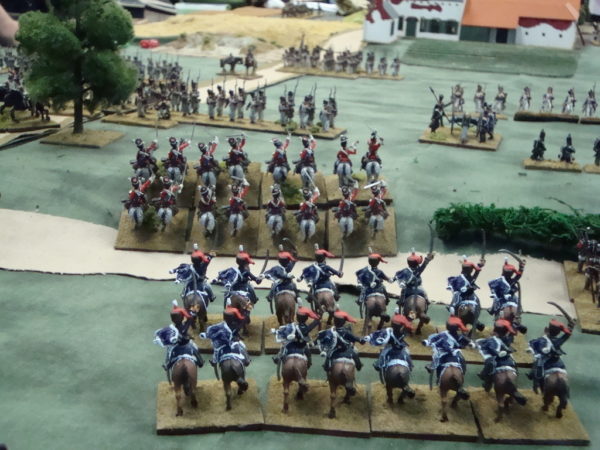
The Allies were not to be outdone. Here Scots Greys, Kings Own 4th Foot and the 6th Belgian Line. Along with French battalions Richard painted up the other companies from the collectors set. Some conversions are an amalgam of parts from Perry, Victrix and Warlord figures which worked very nicely. Since he was basing French battalions on 36 and Brits on 40 figures respectively, he had to supplement boxed sets with other figures to fill out the ranks. Here extra heads were married to extra bodies and metal parts to create additional dynamic poses for Voltigeurs who would be storming La Haye Sainte.
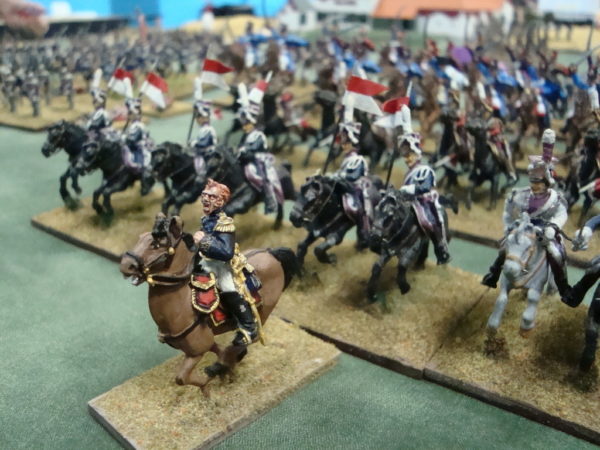
In late February and early March we were inundated with very cold and snowy weather. This, of course, created time for working on minis. By early March, Richard was working on a cuirassier regiment and disorder markers using casualty figures and conversions of extra figures including cavalry for disorder markers. Meanwhile Les was working his way through numerous French battalions. Richard had about 350 figures still to be painted plus the Chateau, and still had to make the large scale scenics. We had purchased all the materials. We just had to find time to put it all together!
Thus far we had made incredible progress for the Plancenoit table; with Prussian Landwehr troops, Plancenoit church was painted and assembled, and another good friend Jeff Kautz volunteered to paint up additional buildings. Matts for the fields surrounding La Haye Sainte and Hougomont along with some 50 plus feet of roads were also complete
Play Test Time
Our first playtest for the event was for the La Haye Sainte table. Immediately, we realized that we needed a six foot wide table instead of the four foot one in Richard’s game room table which is 12 by 4 feet. The scenario rules from the La Haye Sainte box set worked really well. We had an RHA rocket troop on the field which created a lot of damage to the French! Can’t imagine why Wellington didn’t like them!
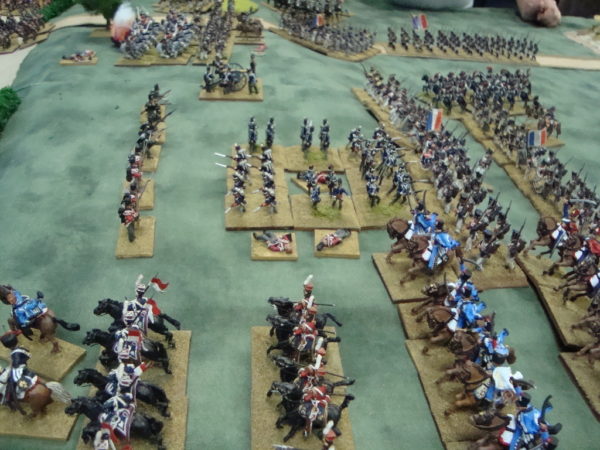
W-60.
That’s the Waterloo Event minus 60 days. The Chateau arrived and a Perry horse artillery team to grace the Plancenoit table. The churchyard complete with gravestones and local dignitary immortalized in bronze were added to the church along with a stout stone wall Richard was down to about 150 figures to paint although he needed only one more French battalion to finish off the units for the battles. Les was working more furiously than ever on Prussians and French. At this point the focus moved from painting figures to scenics with the chateau taking the top priority spot
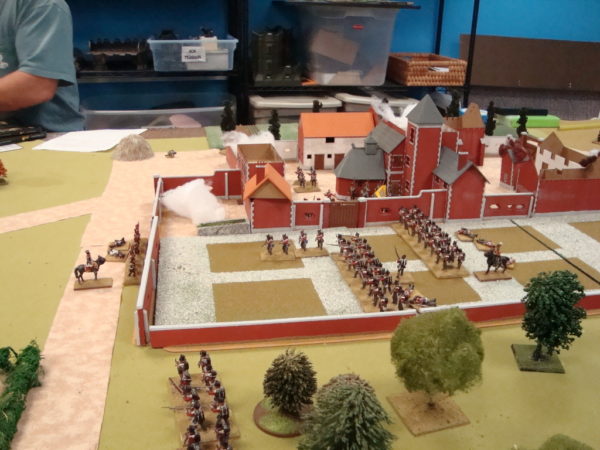
W -30
The scenarios for Plancenoit and Hougomont were straight from the Albion Triumphant Volume 2 book, while La Haye Sainte was drawn from the booklet included with the La Haye Sainte set. We had to reduce the number of units on the French side to about half due to the usual restraints placed on most wargamers, time, space and money!
The closest we approached to a full up scenario was the one for La Haye Sainte with some 800 figures on the table. Hougomont had 600 and Plancenoit another 700
With 12 invitations accepted, Richard was designated as the representative of the dice gods for the day!
Game Time
We had planned on at least four players per table. We ended up with 16 on the day! Here is how the games played. The After Action Reports reflect a variety of styles. The Players really got into the games!
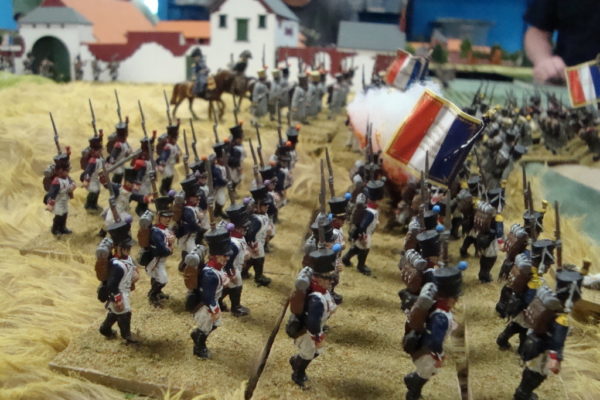
Plancenoit – The French Perspective
Prussians Pummelled at Plancenoit.
Things started well for the French Commanders, when they noted that they barely had enough room in the many houses and the Church to hold their men. This dash of confidence dipped when massive numbers of Prussians arrived on scene, determined to put an end to Napoleon’s 100 day Reign. The Frenchmen girded themselves and made ready for the fury that was about to be unleashed…. And they waited. Perhaps exhausted by the long march, the Prussians struggled to put forth a cohesive line. Multiple Brigade orders were failed, and when they did move, the Freikorp moved sporadically. Thus began the first period of the battle–the Prussian slog.
In this opening phase the Prussians came to blows with the French only haphazardly. Attempts to marshal the troops along modern lines were generally unsuccessful. Despite this, when the opportunity to gain a charge was made, the Prussians manfully took it – albeit typically without supports. Given that the French were well ensconced within their buildings, with cannon covering the main streets, it is not surprising that little headway was made.
Quite a few Prussian units were disordered before they were able to charge, causing further delay as they either halted in place and opened fire, or else fell back to behind fresh comrades in the rear. The biggest gain made was by a quite heroic battalion who managed to clear two buildings, but at the cost of being forced to retire for the day, so great were their casualties. Strategically, although otherwise repulsed and frustrated, the Prussians managed to halfway encircle Lobau’s Sixth Corps static forces. But the delay – both self-inflicted, and by French resistance – was enough to usher in the next phase of the battle.
The Young Guard arrive.
Seeing the town in a Prussian vice, there was only one allowable response from the Guards: l’audace, l’audace, toujours l’audace. Leaping forward with the vigor of youth, and the elan of a true French fighting force, the Young Guard, accompanied by Horse artillery, Lancers and Sabres leaped immediately into a devastating counter attack. Moving the maximum distance two turns in a row, they dramatically covered the same ground in half the time it had taken the Prussians as they pounded upon their opponents. The Lancers and Sabres easily outraced the Guard, forcing the Prussians to form square. This was done as a sacrificial maneuver, but the French cavalry fought savagely.
One square repulsed the onslaught, only to disintegrate as the unit understood the extent of its casualties. Another crushed its cavalry opponent with terrible loss, only to look up at the French attack columns, flying in at their unit, still in square formation. The Sabres in particular acquitted themselves with honor. Weakened by the cavalry, the entire lead formation of the Prussian military reeled backwards, giving up hard won ground, and with hundreds streaming off the field, not to return this day.
Setting up battle lines, the Prussians attempted to rake the French columns with fire, but these attempts were shrugged off by the Guard, who launched bayonet charge after bayonet charge without pausing to shoot. Eventually the sheer weight of support of the Prussians caught up with the elan of the French, but by the time the lines stabilized, the French had managed to re-occupy one of the lost buildings, and reduced the enemy numerical superiority by one-third. Vive le France!
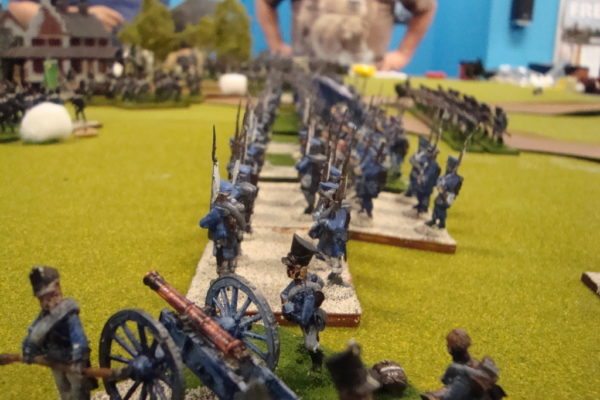
The final phase of the game came when the Prussians began properly leveraging the French out of the buildings. In Black Powder, this is done mainly by having good support. The defenders being too well situated to expect to win on sheer wounds, the value of proper support to force a morale check on the unit defending the building became properly understood, and exploited.
However the hard run of luck continued to dog the attackers. Two French cannon firing grapeshot all game crippled the attack on the famous Plancenoit church, while heroic French resistance was blessed with ill-timed Prussian lack of nerve – no fewer than three units broke and fled the field on morale checks in this phase, a shattering loss for the Prussian commanders, who had spent the entire game painfully manoeuvring their soldiers into such good positions only to see them run the first time that they had to make a check!
With the town attack thus miraculous repulsed, and the Old Guard steadily marching to reinforce the still gamely attacking Young Guard, the Prussians capitulated on turn 9. They retained possession of 1 building, and had lost an estimated 7 or 8 units versus 3 of the French, and with more shaken besides. Whatever becomes of Wellington, his aid would not come through Plancenoit this day.
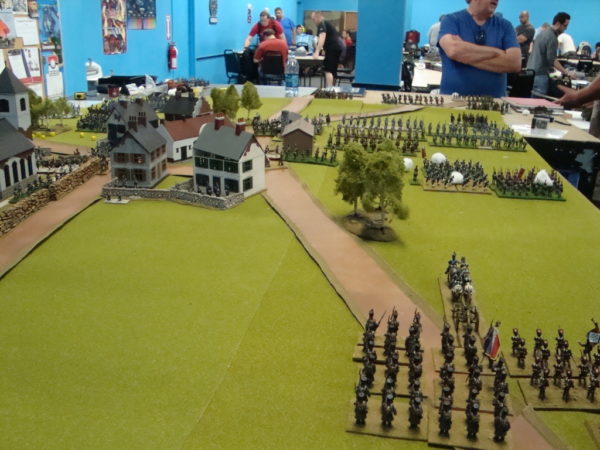
La Haye Sainte – The Allied View
La Haye Sainte was in the middle of the battlefield at Waterloo – Wellington prepared for the French attack by organising his forces into a series of layers;
– Several companies of the Kings German Legion occupying the walled farmstead and orchard located just outside the walls.
– Further back were successive lines of skirmishers pulled away from their parent regiments.
– The third line of defence rested on a long ridge that ran across the width of the La Haye Sainte battlefield – comprised of two batteries of artillery, a Congreve Rocket battery and a Battalion of Belgians.
– The final and strongest line lay just behind that ridge where the full sized battalions of the English waited.
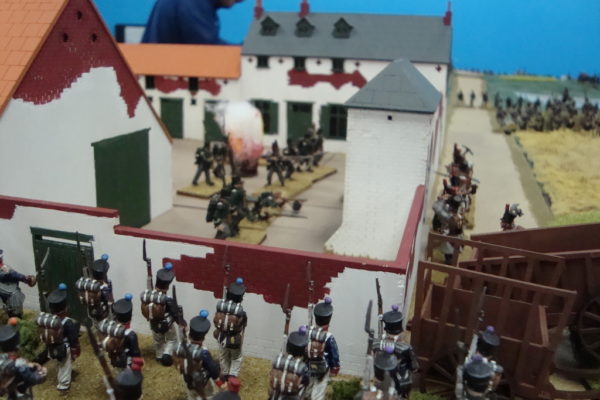
A stillness lay over the battlefield, broken only by the cries of the Motley bird…when a movement through the cornfields leading up to and around the farmstead were noted…soon, the gold imperial eagle standards and French Tricolours could be seen sticking up above the corn stalks…..
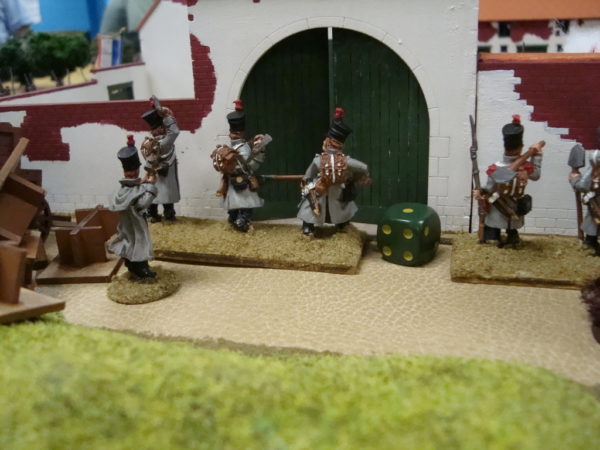
The Allied plan was to hold on to the farm as long as possible, letting the French waves batter themselves in attempts to take it.
Meanwhile our skirmishers would be the second line and attempt to slow down the attacking French columns.
The action around the farm was indeed intense and it was several turns before the French finally scaled the walls and crashing through the barred gates. The gallant defenders were driven from the Farm, their ammunition depleted.
Outside the farm and as the reordered French columns came out of the cornfields, they were met by a withering fire from our skirmish line and long range artillery and rocket fire.
Despite becoming disordered multiple times and taking casualties, the French pressed on, crushing the skirmish line with sheer numbers of foot soldiers or trampling them with Heavy Cavalry.
Once out in the open fields they dressed their ranks and marched up to assault the ridge line.
Seeing charging French Cavalry, the Belgians were the first to form square and despite their reputation for less than able soldiers, they fought to the bitter end.
The French combined arms of Infantry and Cavalry assaulted the ridge and amid cries of Vive L’Empereur crested the top and right into the guns of the waiting main British units.
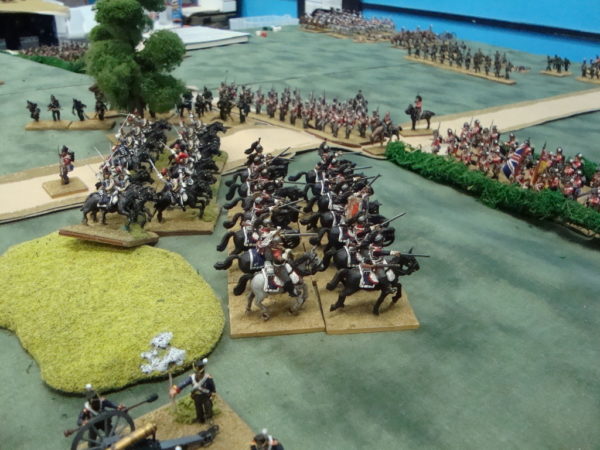
Cavalry charged on both sides but they were already finding out at this time that running over infantry was not an easy task.
The fighting was heavy all along this line but as it was getting close to five (and tea time!) the game was drawn to a close.
The French won a hard fought battle capturing 16 Victory Points to the English 13.
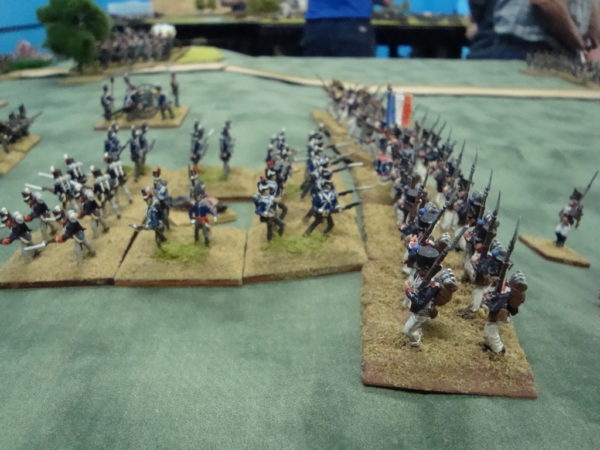
Oh to have been a participant with Richard and Les, hats off to you guys for a fantastic event!
Re-creating your own version of the 100 days Campaign, or the culminating battles around Waterloo, is easy with Black Powder and some of the great sets you can collect with the Starter Armies and Build an Army deals:
